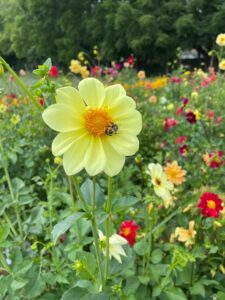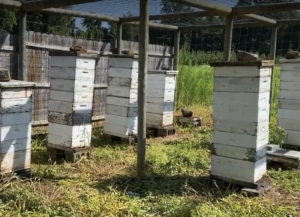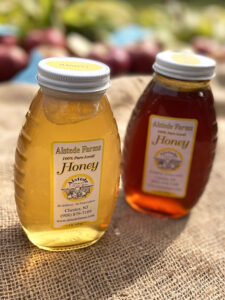Abuzz about Spring
Abuzz about Spring
It’s almost springtime which means you will begin to see pollinators buzzing around our farm. Pollinators are truly a farmer’s friend and so very vital to overall food production. Pollinators include bees, insects, birds, and other small insects that move pollen from one plant to another. Pollen is the yellow dust that you see clinging… Read More »

If you have visited our farm you know that we have our honey bee hives on our farm. The hives
Bees have plenty of flowers to choose from on our farm as we grow over 250 varieties of fruits and vegetables along with flowers such as sunflowers, zinnias, and cosmos. Our bees will collect the pollen and nectar from the flowers on these plants and bring them back to the hive. Honey starts as nectar and then gets broken down into simple sugars by saliva and enzymes and then stored inside the six-sided wax cells known as honeycomb until retrieved.
Honey is an ancient product dating as far back as 8,000 years ago according to some historians as it was seen depicted in Stone Age paintings around that time. It is believed that ancient civilizations used honey to cure ailments and provide wound treatment. Some medical professionals today tout that consuming raw honey before the spring season can keep seasonal allergies at bay. Honey is great as a natural sweetener, some use it for its natural anti-inflammatory properties as well as antioxidant and antibacterial agents. Raw honey is as natural as it gets and is an unprocessed food.

Upon entering our market all eyes naturally gravitate to the beautiful amber-colored liquid in jars near the entrance, that is our raw honey! Our raw honey is a popular feature on our farm for people seeking natural alternatives to sweeteners along with the other benefits of consuming local honey. One taste of our honey and you will know it’s good for you. Find an inspiring recipe for honey-glazed carrots on our website.
Soon it will be springtime (spring starts officially on March 19th this year) and we already have some cold-weather transplants and cold-tolerant pansies, tulips, and daffodils available in our farm store. Stop in and bring a little sunshine and color indoors with these happy little plants and pick up some honey while you visit! Watch our video on YouTube here.







